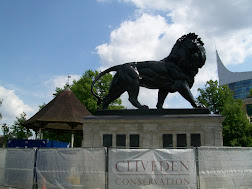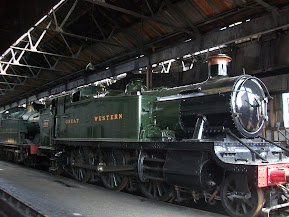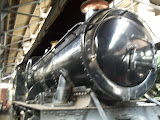Fittingly this sojourn began with me catching three trains in rapid succession until finally I reached my first port of call, Didcot Railway Centre, situated directly next to Didcot Parkway Station.
The Centre features a collection of Great Western
Railway (GWR) steam locomotives, carriages, wagons and buildings in a
twenty-one acre living museum set around the original 1932 Engine Shed. It was
the latter’s appearance in ‘Sherlock
Holmes: A Game of Shadows’ (2011) that I wished to visit. There are a
number of scenes filmed in the Engine Shed which appears as a German armaments
factory. Therefore, having paid for entrance, I made my way directly to the
Engine Shed, taking several photos of the entrance and inside where Watson
(Jude Law) saves Holmes (Robert Downey Jr) from the hands of Moriarty in an
explosive fight scene.
Several GWR locomotives are present in the scene, with the most readily identifiable being the 6100 Class No. 6106, whose number is clearly visible behind our heroes. Others including 5700-series No. 3738 and 5600 Class No. 6697 can also be made out, hidden amongst all the military hardware. I therefore sought these particular locomotives.
The Engine Shed also appeared as Moscow Station in ‘Anna Karenina’ (2012) [starring Keira Knightley], which also featured 4300 Class No. 5322 and 2884 Class No. 3822.
It also featured as a Paris engine shed in ‘Partners in Crime’ (2016) [starring Jessica Raine & David Walliams]. The Centre also appeared as Marylebone Station in ‘One of Our Dinosaurs Is Missing’ (1975). Around the Shed were several displays referring to filming with one referring to the filming of ‘SH: AGOS’, where a false wall was built by the nearby Enquiry Office then later blown up. A greenscreen was erected to act as the forest backdrop, with the Centre’s coaling tower standing proud in some shots.
The Centre regularly holds events such as steam and diesel railway days, and appeared as itself in ‘Inspector Morse: The Wolvercote Tongue’ (1987), when Howard Brown (Bill Reimbold), a suspect in the death of Laura Poindexter (Christine Norden), visits one of these events. Lewis follows him to the event, radioing Morse to join him. They then question Brown as to what the missing Eddie Poindexter (Robert Arden) stood to gain by his wife’s death. Later, on the platform at Didcot Parkway, Brown sees the missing husband with his long-lost daughter departing on a train, and captures this scene on his camcorder.
I then made my way to the Centre's Museum, stopping off briefly at the gift shop but not buying anything. As well as looking at a large number of smaller artefacts, I also paid 20p for an ‘old Penny’ to use in a Platform Ticket Machine as a memento. Just around the corner was the Signalling Centre, with levers to pull aplenty, showing how trains have been controlled since Victorian times. Continuing along a path, and passing over a giant turntable, I reached the Carriage Display Shed which included several Victorian carriages.
Further on was a pipe from Isambard Kingdom Brunel’s Innovative Atmospheric Railway. This 22” diameter cast iron pipe was used on the South Devon Railway (visited on two previous sojourns) between Exeter and Newton Abbot, with stationary pumping engines creating a partial vacuum in these pipes laid between the rails. The partial vacuum allowed a piston attached to a carriage to be propelled by the greater pressure of the atmosphere behind.
I then reached Oxford Road Station at the far end of the Centre’s demonstration line, but found that trains were not running due to it being lunchtime. However, a short walk took me to Burlescombe Station, at one end of the Centre’s branch line. This featured replicas of Iron Duke and Firefly, the high-speed trains of the 1840s, along with reproductions of the primitive carriages from that era.
Having taken photos of these, it was time to board a short train pulled by Diesel Locomotive D9516 (‘Teddy Bear’) for the short journey to Didcot Halt and back.
Walking back the way the train had just gone, I had a final look in the Engine Shed, before an announcement indicated that the demonstration line had re-opened. I therefore made my way to Eynsham Station, catching a service pulled by steam locomotive No. 2409 (’King George’) up to Oxford Road and back (a journey of 10-15 minutes).
It was then time to leave the Centre, and I made my way back to Didcot Parkway Station, catching a train back to Reading Station. Back in Reading, the first site of interesting was the Station which was used by Victor Hatherley and then by Holmes, Watson and the police, to travel to Lysander Stark’s House in ‘The Engineer’s Thumb’. After alighting here, Hatherley had to change railway stations to catch a train to Eyford (visited on a previous sojourn). Although the station has been redeveloped since then, ‘The Three Guineas’ Public House is located in the old ticket hall of the railway station and is contemporary to the story.


“At Reading I had to change not only my carriage but my station. However, I was in time for the last train to Eyford, and I reached the little dim-lit station after eleven o’clock” – Victor Hatherley [ENGI].
A five minute walk brought me to Forbury Gardens, a Victorian town garden, created at the height of the urban parks movement. In the centre of the park is the Maiwand Lion, a sculpture and war memorial. The statue was named after the Battle of Maiwand (in which Watson was injured at the start of ‘A Study in Scarlet’) and was unveiled in December 1886 to commemorate the deaths of 329 men from the 66th (Berkshire) Regiment of Foot during the campaign in the Second Anglo-Afghan War in Afghanistan between 1878 and 1880. It is sometimes known locally as the Forbury Lion.


When I visited, the Lion was undergoing some conservation work to ensure that it can be enjoyed by visitors to the gardens for generations to come. Specialist conservation experts, Cliveden Construction - who previously conserved the nearby Abbey Ruins - had been working on the Lion since March 2023, and were approaching the six week planned completion date.
Continuing on, I reached the former site of Reading Gaol, built in 1844 as the Berkshire County Gaol on the site of the former county prison, alongside the ruins of Reading Abbey, and closed in 2014. Designed by George Gilbert Scott and William Boynthon Moffatt, it was based on London's New Model Prison at Pentonville with a cruciform shape, and is a good example of early Victorian prison architecture. Its most famous inmate was Oscar Wilde who was incarcerated in Reading after being convicted of gross indecency with other men in 1895 and sentenced to two years' hard labour in prison. At Reading, Wilde was reduced from a famous highly-acclaimed name down to a code, namely ‘cell number C33’.
After his release, he published ‘The Ballad of Reading Gaol’ in 1898, narrating the 1896 execution of Charles Thomas Wooldridge who was convicted of cutting the throat of his wife, Laura Ellen, earlier that year at Clewer, near Windsor. At the time of my visit the walls also included a Banksy artwork.


There is a pit of shame,
And in it lies a wretched man
Eaten by teeth of flame.’ [‘The Ballad of Reading Gaol’, 1898]
Wilde and Sir Arthur Conan Doyle were friends, meeting at a dinner with the publisher of Lippincott's Monthly Magazine on 30 August 1889 at the Langham Hotel in London, that led to Wilde writing ‘The Picture of Dorian Gray’ and Conan Doyle writing the second Holmes novel, ‘The Sign of Four’, which in turn led to his beginning to write Sherlock Holmes short stories for The Strand Magazine. Conan Doyle was very taken with the bohemian Wilde with some of his characteristics being subsumed into Holmes from the second novel onwards. [I intend to visit London sites associated with Wilde in a future sojourn]
Continuing on to the nearby River Kennet, I reached the
‘Oscar Wilde Memorial Walk’ commissioned by Reading Borough Council in
the 2000 from the artist Bruce Williams and the poet Paul Muldoon to
commemorate the life and work of Wilde on the centenary of his death. It
comprises two gates with the image of Wilde, railings incorporating poetry by
Muldoon and Wilde’s declaration on release - ‘Oh beautiful world’, three
love seats and a wood and stone bench the same size as his prison bed.
I then walked back into central Reading to browse the shops and get some food prior to catching a bus for fifteen minutes to nearby Caversham (a stone's throw from [Lower] Grove Road, where the bust containing the Black Pearl of the Borgias ended up in 'The Six Napoloeons'), and the Milestone Centre for my evening’s entertainment – ‘Sherlock Holmes: The Curious Case of the Cow in the Spotlight’ being performed by Caversham Park Theatre Company. I had previously seen the same group’s ‘The Trial of Sherlock Holmes’ at the same venue in 2019. The previous production’s Watson (Dan Bretherton) was now playing Holmes, with the author of that production (Roger Utting) playing Watson. The play written by the director, Bob Sturgess (who also played Lestrade) involved the investigation of the shooting of the front end of a pantomime cow during rehearsals for the Crouch End Ladies Thespian Society’s latest production


After an enjoyable night at the theatre, I had just enough time to make my way to the nearby bus stop to catch a bus back into central Reading, then a train back to Clapham Junction, from which I could catch my train home. It had been a long and slightly tiring day.























